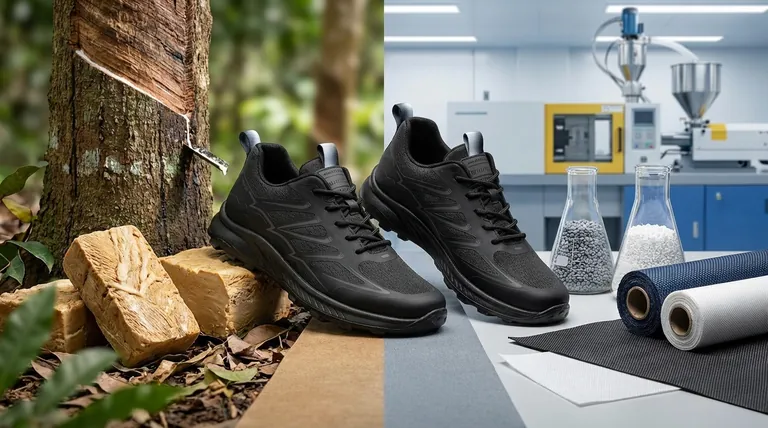At its core, the widespread adoption of synthetic materials has fundamentally displaced natural rubber in most modern footwear, especially trainers. This shift is driven by the significant advantages synthetics offer in cost, weight, and manufacturing efficiency, making them the default choice for mass-market shoe production.
The transition from natural rubber to synthetics in footwear is not about one material being universally better, but a calculated trade-off. Manufacturers gain cost-efficiency and lower weight at the expense of the superior grip and environmental sustainability inherent to natural rubber.

The Rise of Synthetics: A Shift in Priorities
The dominance of synthetic materials like plastics, PVC, and nylon in footwear is a direct result of their alignment with modern manufacturing and consumer demands. They solve key logistical and performance challenges that have long been associated with natural materials.
The Economic Imperative
Synthetic materials are significantly easier and cheaper to source than natural rubber. Their production is not dependent on agricultural cycles, providing a stable and predictable supply chain essential for large-scale manufacturing.
The Performance Mandate
Weight is a critical factor in athletic footwear. Synthetics are considerably lighter than natural rubber, which directly contributes to the performance and comfort of modern trainers. They also offer excellent durability and water resistance.
Overcoming Past Limitations
Historically, a major drawback of synthetics was poor breathability. However, advances in production technology have largely solved this issue, allowing synthetic shoes to compete effectively with natural materials on comfort.
Where Natural Rubber Still Excels
Despite the prevalence of synthetics, natural rubber retains key advantages in specific high-performance applications where its unique properties are non-negotiable.
Unmatched Grip and Comfort
Natural rubber provides a superior grip and a more comfortable feel underfoot compared to most synthetic alternatives. This makes it the preferred material for applications where maximum traction is critical.
Superior Thermal Stability
Natural rubber has a higher temperature resistance than typical synthetic options. This ensures its performance characteristics remain stable and reliable across a wider range of conditions.
Understanding the Trade-offs
Choosing between natural rubber and synthetic materials involves a clear set of compromises. Understanding this balance is key to evaluating footwear design and material selection.
The Environmental Equation
This is the most significant trade-off. Natural rubber is biodegradable and sourced from renewable rubber trees. In contrast, synthetic rubber and plastics are derived from petrochemicals and are non-biodegradable, posing a long-term environmental challenge.
Performance Consistency vs. Specialization
Synthetics offer consistent, versatile, and budget-friendly performance for a wide range of uses. Natural rubber is a specialist material, offering peak performance in grip and comfort but at a higher cost and weight.
Making the Right Choice for Your Goal
The decision to use natural rubber or a synthetic alternative is entirely dependent on the primary goal of the footwear.
- If your primary focus is mass-market production and affordability: Synthetics are the clear choice due to lower cost, lighter weight, and supply chain stability.
- If your primary focus is high-performance grip and feel: Natural rubber remains the superior material for applications demanding maximum traction and comfort.
- If your primary focus is environmental sustainability: Natural rubber from renewable sources is the definitive winner over non-biodegradable, petrochemical-based synthetics.
Ultimately, understanding this material trade-off empowers you to select or design footwear that is perfectly aligned with its intended purpose and values.
Summary Table:
| Material | Key Advantages | Ideal For |
|---|---|---|
| Synthetic Materials | Lower cost, lighter weight, stable supply chain | Mass-market production, athletic footwear |
| Natural Rubber | Superior grip, biodegradability, thermal stability | High-performance applications, eco-friendly products |
Need the right material for your footwear line?
As a large-scale manufacturer, 3515 produces a comprehensive range of footwear for distributors, brand owners, and bulk clients. Our production capabilities encompass all types of shoes and boots, and our expertise in material selection ensures your products are perfectly aligned with your cost, performance, and sustainability goals.
Contact our experts today to discuss your project and receive a tailored solution.
Visual Guide

Related Products
- Custom OEM Training Shoes Wholesale Manufacturer Durable & Breathable
- Wholesale Durable & Breathable Training Shoes for Custom Brands
- Safety Footwear Wholesale Manufacturer for Custom OEM/ODM Production
- Lightweight Breathable Sneakers with Wet-Traction Grip for Wholesale & Private Label
- Wholesale Comfortable Business Casual Shoes Custom Manufacturing
People Also Ask
- What are the main types of reinforced toe protection for tactical boots? Choose the Right Toe for Your Mission
- What industries benefit from safety trainers? Lightweight Protection for Modern Workplaces
- What is Athlete's Foot, and how does it spread? Prevent Contagious Fungal Infections
- Which type of footwear is better suited for prolonged use in tough environments? Choose Durable Boots for Maximum Safety & Comfort
- What is the purpose of cushioning in running shoes? Absorb Impact, Boost Performance



















